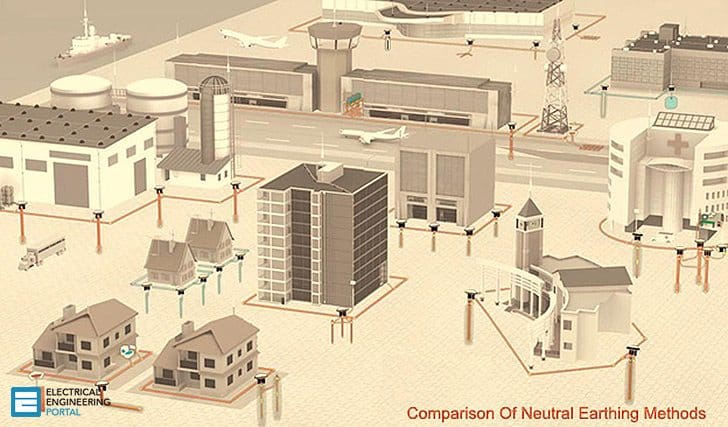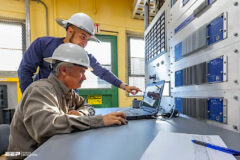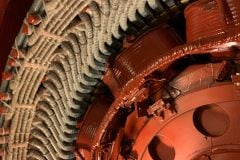Methods Of Neutral Earthing
Neutral earthing systems are very similar to circuit breakers in that they do nothing until something in the system goes wrong! There are several methods for system earthing which can be generally divided into three main categories: Insulated earthing, Solid earthing (the most common system arrangement), Impedance earthing through resistor and reactanse or arc-suppresion coil (Petersen coil).

Table of contents:
- Insulated earthing
- Solid earthing (the most common system arrangement)
- Impedance earthing through resistor, reactanse or arc-suppresion coil (Petersen coil)
- Comparison table
INSULATED NEUTRAL SYSTEM (No Intentional Earthing)

The neutral is not earthed directly. In reality,the electrical system is earthed through the system capacity to earth.
The earth fault causes a few amperes fault current due to the cable capacitance current, and the voltage of healthy phases will not rise above the line to line voltage. So, the system can operate with present earth fault improving the system continuity and supply.
SOLIDLY EARTHED OR DIRECT EARTHING

The neutral of power transformers or generator is directly connected to station ground.
The Fault current = the three phase symmetrical short-circuit current and can rise from 20 to 30 times the nominal current. The over-voltage in the healthy phase will not exceed the line to earth voltage.
IMPEDANCE EARTHING
The purpose of this method is to limit the fault current for greater safety. There are three type of impedance earthing through:
1. EARTHING THROUGH RESISTOR

The neutral is connected to earth through one resistors. The fault current is limited to chosen value: If=V/R
R = resistance value of resistor (W)
V = line to earth voltage (kV)
A system properly earthed by resistor is not subject to destructive transient over voltages.
The reasons for limiting the current by resistor may be one or more of the following:
- To reduce burning and melting effects in faulted electric equipment,
- To reduce mechanical stresses in circuits and apparatus carrying fault currents,
- To reduce electric shocks hazards are blast to personnel caused by stray ground fault currents in the ground return path.
In practice there is a clear difference.
- High resistance value typically uses earth fault current levels of 10 A or less.
- Low resistance value typically uses ground fault current levels above 10 A and up to 3000 A .
Both classes are designed to limit the earth fault current and to keep the system free from transient over voltages (maintained to a safe level). However, the high resistance method usually does not require immediate clearing of a earth fault since the fault current is limited to a very low level, the protective scheme associated with high resistance value is usually detection and alarm.
The low resistance method has the advantage of immediate and selective clearing of the earthed circuit, but requires that the minimum earth fault current be large enough to positively actuate the applied earth fault relay.
Go to Index ↑ | Go to Earthing through impedance ↑
2. EARTHING THROUGH REACTANCE

The neutral is connected to earth through reactor .
The ground fault that may flow is a function of the neutral reactance, the level of the fault current is often used as a criteria for describing the degree of grounding.
This system is used when the system neutral transformer is not available (DELTA connected system) in such case the reactor is used as transformer grounding to obtain the neutral .
Go to Index ↑ | Go to Earthing through impedance ↑
3. EARTHING THROUGH ARC-SUPPRESSION COIL (Petersen Coil)

An earthing reactor connected between the neutral of a system and earth and having a specially selected, relatively high value of reactance in such that the reactive current to earth under fault conditions balances the capacitance current to earth flowing from lines so that the earth current at the fault is limited to practically zero
Since systems of such construction are rarely used in industrial or commercial power systems.
Go to Index ↑ | Go to Earthing through impedance ↑
Comparison Table

X0: Zero-Sequence reactance of the system
X1: Positive-Sequence reactance of the system
R0: Per phase zero-sequence resistance of the system
XC0: Distributed per phase capacitive of reactance to ground the system
V: Line to ground voltage
Reference: Microelettrica Scientifica – M.S. Resistances











the Peterson coil is used above the operating conditions of 110kv, while the resistance earthing is reduced to 33kv and below
Thanks for these article of earthing methods and comparison. Select of the earthing method also can do these article using fault level calculator and then.
I except more articles in details so that fundamental is clear
Thanks
Kate
how to earthing a swimming pool
how to earthing a swimming pool – any help please
Superb initiative to help engineers
A Neutral free 1:1 transformer can actually protect us? In such a system can i touch the phase line while standing on the roof? Please clear my confusion..!
No you can not touch live lines in unearthed network because you may get shocked due to the capactive current .